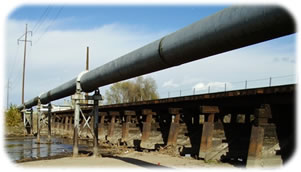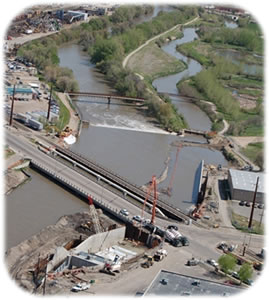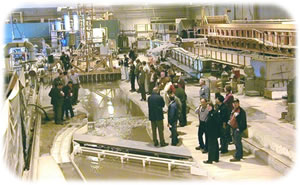 |
South Platte River North Globeville Area Flood Control Project By: Nancy Boudreau Love, CFM and David J. Love, P.E. Love & Associates, Inc. The South Platte River project in North Denver (Globeville Area) is the single largest flood control project undertaken by either the Urban Drainage and Flood Control District (UDFCD) or the City and County of Denver. It represents state-of-the-art water resources engineering. When completed, it will remove over 300 acres of land in north Denver and south Adams County from the 100-year floodplain. It will also grade separate one of the two remaining at-grade street crossings of the South Platte River Greenway Trail, connecting Adams County and Denver trail systems with a new pedestrian bridge over the river and an underpass at Franklin Street and the Denver Rock Island Railroad (DRIRR).
The full project was implemented in three separate phases. Phase I, completed in May 1997, consisted of 2,000 linear feet of channel improvements including levees, trails, bank stabilization, aquatic and wildlife habitat improvements, landscape plantings, and removal of a large abandoned sanitary sewer that crossed the river, thereby removing a major obstruction to flow. Phase II, completed in August 1998, included additional floodwalls and levees, bank stabilization, trails, aquatic and wildlife habitat, wetland creation and landscape plantings.
Also included in the total project are the construction of grade control weirs, removal and replacement of the (DRIRR) bridge downstream of Franklin Street, and removal and reconstruction of a 36-inch Denver Water Department suspended ‘gray’ water line which bridges the channel. In addition, this project incorporates construction of scour protection of the river bottom and banks, aquatic and wildlife habitat improvements, and a new and improved riparian corridor along the banks of the river. Obtaining a 404 Permit, other USFW&S regulatory permitting, and FEMA floodplain submittals have been key components of this project; as well as gaining approvals from all the adjacent landowners and the railroad, and water users. The total design-construction cost for all three phases will be just under $25,000,000. This project has faced significant challenges since its inception in 1995 when Love & Associates was contracted to provide an updated preliminary design and construction documents for this reach of the South Platte. To assure FRICO, UDFCD and Denver that the proposed system would work as well or better than the current water diversion system, the design was physically modeled twice at the Colorado State University Hydraulics Laboratory in Fort Collins. This verified that the improvements would not change the quantities of water being delivered to FRICO while containing the 100-year flood as designed. The first physical model was completed in 2001 and the second in 2003 with modifications and the addition of a closed box culvert system requested by FRICO. Groundwater and river flows have caused a myriad of problems during construction, especially during Phase III. Despite these obstacles, the Phase III contractor, Lawrence Construction, maintained the projected completion date, dealing sometimes heroically with the ‘water-water-everywhere’ issues arising on a daily basis, and larger snowfall and colder winter temperatures than normal.
Love & Associates was the lead design engineer, supported by Bates Engineering for the design of structural components. Ben Urbonas of the UDFCD provided much technical and practical guidance to the design team. His experience with working with riverine systems and the South Platte River system in particular provided insights into problems that needed to be anticipated and in how to deal with them in a practical, cost-effective, manner. The City of Denver’s Wastewater Management Division staff was very supportive of the design efforts and assisted the Love & Associates design team in obtaining the necessary permits. Most importantly they were able to secure the funding needed to complete this important flood control project on Denver’s northern border that also provided an important link in the South Platte River greenway trail system with an underpass at the Franklin Street and the DRIRR bridges. |



